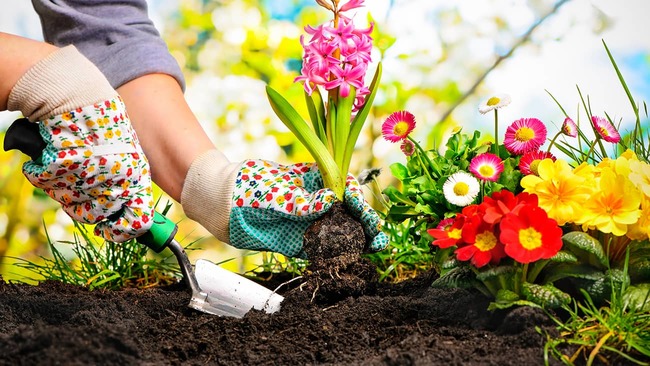How to Prepare Your Garden for Summer

After completing their spring cleanups, most homeowners sit back and relax without thinking to prepare their garden for the hot summer months.
Leaves pop out, grass grows, and plants are blooming. Since everything looks good, you are confident that nothing needs to be done. But before you know, the blooms are gone, weeds explode, and the plants are dying.
Seasons change and plant behaviors change, too. You can work with Mother Nature by doing some simple tasks and see that your garden thrives this summer.
Clean garden beds
The temperatures begin to warm and plants start to rise from their winter’s slumber. Now’s the time to get your hands dirty with some cleaning of your garden beds.
Remove debris
While raking the leaves, look out for debris and remove it. This will eliminate mold growth and keep plants healthy. Mulch the leaves to decompose and provide nutrients to your garden beds.
Trim and prune
Trim stems and crop your shrubs and bushes. Remove dead annuals and replace them with new ones.
Compost spent plants
Throw non-diseased plant material in the compost bin for use in the coming seasons.
Mulch
A thin layer of mulch will keep the weeds away and moisten the soil.
Gardening involves a lot of physicality; the muscles you haven’t been using will be aching for days. If the work is too excessive, consider hiring a landscape maintenance service provider. These professionals will keep your garden aesthetically attractive and easy to maintain.
Get rid of weeds
Your beautiful garden becomes an eyesore with weeds sticking out like a sore thumb. They are undesirables robbing your plants of water and nutrients. The reality is that weeds must go in order for you to enjoy a picture-perfect garden.
Dig them up
This is the hard way but the best way to say goodbye to weeds with stubborn roots.
Be careful with digging, as this might bring weed seeds to the surface and populate. Dig only when needed and apply mulch on the disturbed spot. Use a sharp, narrow-bladed knife to slice the roots of weeds to cut their food source.
Keep garden edges trimmed
Most lawn mowers don’t do a good job of cutting weeds at the edges of your garden. Consider a trimmer, especially if tough, repulsive weeds have grown.
Minimize open space
If your soil is fertile and empties well, keep your plants close. This way weeds have no space for growth.
Spot killers
You can ditch weeds that find their way through breaks in patios or walkways by pouring bleach. A solution of a cup of salt melted in two cups of hot water will also do the trick.
Prepare your soil
Healthy soil grows healthy plants and keeps the environment happy. Soil can be improved to support plant roots and continue plant growth for years to come.
Improve your soil
Most garden soils can be enhanced by adding organic matter to make it functional. The matter loosens tight soil, allowing air to enter. You’ll also find that it holds more water (making it easier to dig) and supplements nutrients.
Good organic soil is:
-
Rich in decaying leaves, grass trimmings, and compost
-
Loose, soft, and filled with air that roots need
-
A superior alternative to fertilizers and pesticides
-
Packed with minerals to ensure solid plant growth
Till the soil
The soil should be loosened as deep as possible to allow plant roots to go deeper. Prior to planting, remove any debris on the surface, rake, and level it.
Mulch
Apply mulch to protect the soil from severe heat and cold, reduce water loss, and prevent weed growth. When it breaks down, organic matter seeps into the soil, making it healthy.
Start composting
Compost is a mixture of dead organic materials like vegetable and fruit scraps, coffee grounds and filters, plant trimmings, leaves, twigs, herbs, eggshells, and more. It is rich in nutrients and fertilizer for plants. Just be mindful that animal products are not good things to compost.
Composting starts when you stack up organic materials in a bin. It should be set in a sunny place, leveled, and well-drained where the heap stays warm and damp. Then layer anything from dried leaves and coffee grounds to plant trimmings and manure. For best results, use a ratio of one-third greens and two-thirds brown materials.
Mix and turn the blend once a week to decompose the organic materials. Full decomposition takes about six months and it is ready when the color changes to dark brown, powdery texture, and smells like soil.
Plant summer flowers and bulbs
While the blooms of hyacinth, tulips, and daffodils brilliantly light your spring garden, start adding to the space with flowering bulbs and get rewarded with bursts of bright summer colors.
Get some inspiration from our pick of bulbs that blossom this time of year.
Oriental lilies
The large, sweet-smelling flowers are certified showstoppers in your garden. There is a wide variety to choose from, and it comes in different sizes and colors to suit any garden.
Begonia
Make your shady patios vibrant with bright colored begonias. You will love these long-lasting beautiful flowers from summer to the first frosts in November.
Crocosmia
Delicate flower chains in shades of orange, red, and yellow will make your garden look absolutely stunning.
Dahlia
Dahlias are quite showy. Cut the blossoms off and they will show more flowers until frost stops them. They come in rainbow colors and can get as big as a plate.




